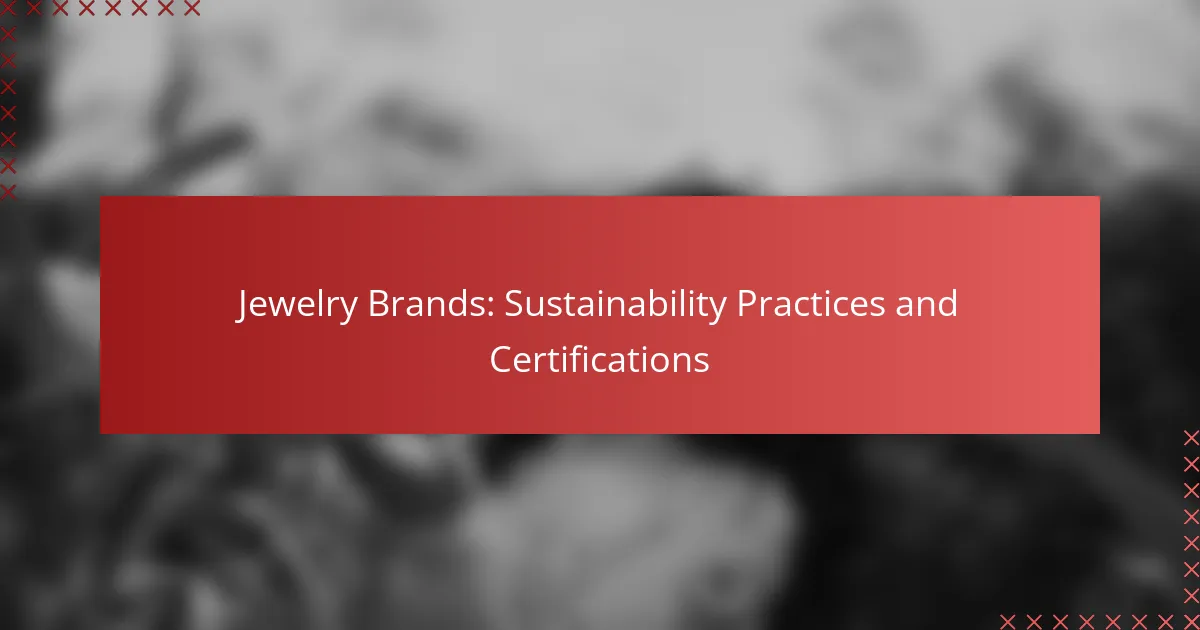In recent years, numerous jewelry brands in the USA have prioritized sustainability by adopting ethical sourcing, eco-friendly materials, and responsible manufacturing processes. These brands not only aim to reduce their environmental footprint but also promote social responsibility within the industry. Certifications such as Fair Trade Certified and Responsible Jewelry Council Certification further validate their commitment to ethical practices and environmental stewardship.
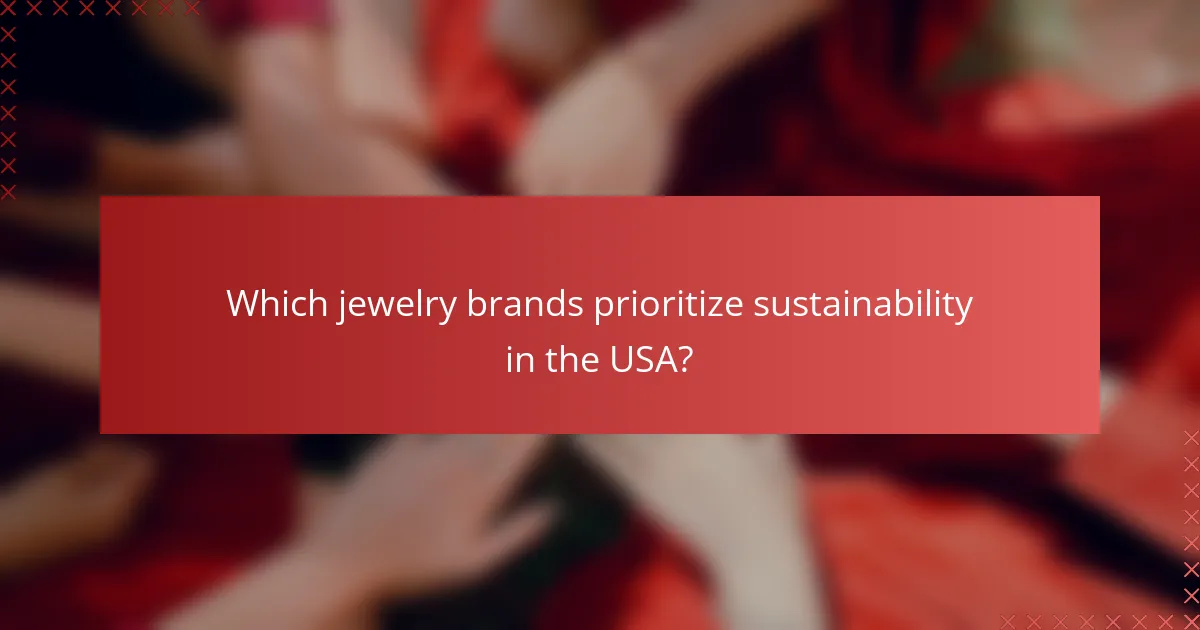
Which jewelry brands prioritize sustainability in the USA?
Several jewelry brands in the USA focus on sustainable practices, emphasizing ethical sourcing, eco-friendly materials, and responsible manufacturing processes. These brands aim to minimize their environmental impact while promoting social responsibility within the jewelry industry.
Brilliant Earth
Brilliant Earth is renowned for its commitment to ethical sourcing and sustainable practices. The brand offers conflict-free diamonds and recycled precious metals, ensuring that their materials do not contribute to environmental degradation or human rights abuses.
They also engage in various philanthropic efforts, including partnerships with organizations that support communities affected by mining. Customers can trace the origins of their jewelry, providing transparency in the sourcing process.
Catbird
Catbird is a Brooklyn-based jewelry brand that prioritizes sustainability through its handmade pieces and use of recycled materials. The company sources its gold from recycled sources and is committed to using ethically mined gemstones.
Additionally, Catbird emphasizes local craftsmanship, producing all its jewelry in-house, which reduces its carbon footprint. Their dedication to sustainability extends to packaging, using eco-friendly materials for shipping.
Vrai
Vrai specializes in lab-grown diamonds, which significantly reduce the environmental impact associated with traditional diamond mining. By using innovative technology, Vrai creates diamonds that are chemically identical to mined stones but come with a lower ecological footprint.
The brand also focuses on sustainable practices in its manufacturing processes, ensuring minimal waste and energy consumption. Vrai’s commitment to transparency allows customers to understand the benefits of choosing lab-grown over mined diamonds.
Jewelers of America
Jewelers of America (JA) is an organization that promotes ethical practices among its members. They advocate for responsible sourcing and provide resources for jewelers to adopt sustainable practices.
JA also offers a certification program that helps consumers identify jewelers committed to ethical standards. By supporting JA-certified jewelers, customers can ensure their purchases align with sustainability principles.
Green Karat
Green Karat is a pioneer in eco-friendly jewelry, focusing on recycled precious metals and ethically sourced gemstones. The brand emphasizes sustainability by offering a range of customizable jewelry options that cater to environmentally conscious consumers.
They also provide a unique service where customers can recycle their old jewelry, transforming it into new pieces. This approach not only reduces waste but also encourages a circular economy within the jewelry industry.

What sustainable practices do jewelry brands implement?
Jewelry brands are increasingly adopting sustainable practices to minimize their environmental impact and promote ethical standards. These practices include ethical sourcing of materials, using recycled metals, achieving carbon-neutral production, and ensuring fair labor practices.
Ethical sourcing of materials
Ethical sourcing involves obtaining raw materials from suppliers that adhere to environmental and social standards. This means avoiding conflict minerals and ensuring that gemstones and metals are mined responsibly, often certified by organizations like the Responsible Jewelry Council.
Brands may also prioritize partnerships with local communities to support sustainable mining practices that benefit both the environment and the people involved. Transparency in the supply chain is crucial, allowing consumers to trace the origins of their jewelry.
Recycled metals usage
Many jewelry brands are turning to recycled metals to reduce the demand for newly mined resources. Using recycled gold, silver, and platinum can significantly lower the environmental footprint associated with mining and refining processes.
Recycled metals are often indistinguishable from newly mined ones, making them a viable option for consumers who want to make eco-friendly choices. Brands may highlight their use of recycled materials in marketing to appeal to environmentally conscious shoppers.
Carbon-neutral production
Carbon-neutral production refers to the process of balancing the carbon emissions produced during manufacturing with equivalent reductions or offsets. Jewelry brands can achieve this through energy-efficient practices, renewable energy sources, and carbon offset programs.
Some companies invest in reforestation projects or renewable energy initiatives to counterbalance their emissions. Consumers can look for brands that publicly commit to carbon neutrality and provide transparency about their production processes.
Fair labor practices
Fair labor practices ensure that workers involved in the jewelry supply chain receive fair wages and work in safe conditions. Brands committed to ethical practices often conduct audits and work with suppliers who comply with labor regulations.
Supporting fair labor practices not only helps improve the lives of workers but also enhances the brand’s reputation. Consumers can seek certifications or memberships in organizations that advocate for fair labor standards in the jewelry industry.
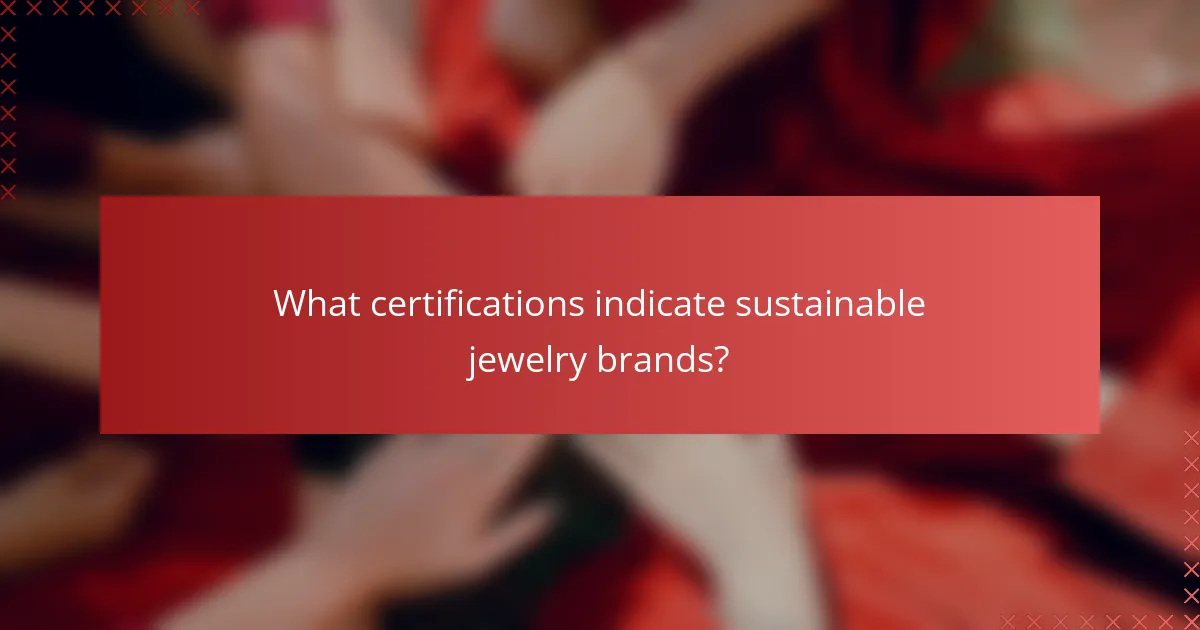
What certifications indicate sustainable jewelry brands?
Certifications that indicate sustainable jewelry brands include Fair Trade Certified, Responsible Jewelry Council Certification, GIA Ethical Practices, and ISO 14001 Certification. These certifications ensure that jewelry is produced ethically, with consideration for environmental impact and social responsibility.
Fair Trade Certified
Fair Trade Certified jewelry ensures that artisans and workers receive fair wages and work in safe conditions. This certification promotes sustainable practices by requiring transparency in the supply chain and encouraging environmentally friendly production methods.
When purchasing Fair Trade jewelry, look for brands that provide clear information about their sourcing and labor practices. This certification often applies to materials like gold and gemstones, ensuring that they are mined and processed responsibly.
Responsible Jewelry Council Certification
The Responsible Jewelry Council (RJC) Certification focuses on ethical, social, and environmental practices within the jewelry supply chain. Brands that achieve this certification must adhere to a comprehensive set of standards that promote responsible sourcing and production.
RJC-certified brands often undergo rigorous audits to verify compliance with their ethical commitments. Consumers can trust that these brands prioritize sustainability and social responsibility in their operations.
GIA Ethical Practices
The Gemological Institute of America (GIA) promotes ethical practices in the jewelry industry through its guidelines and educational programs. While GIA does not offer a certification, it encourages jewelers to adopt responsible sourcing and transparency in their business practices.
Brands that align with GIA’s ethical practices often provide detailed information about the origin of their gemstones and the methods used in their extraction. This commitment helps consumers make informed choices about their jewelry purchases.
ISO 14001 Certification
ISO 14001 Certification is an international standard that specifies requirements for effective environmental management systems. Jewelry brands that obtain this certification demonstrate their commitment to minimizing environmental impact and improving sustainability practices.
When considering ISO 14001-certified brands, look for those that actively engage in reducing waste, conserving resources, and promoting eco-friendly materials. This certification indicates a proactive approach to environmental stewardship in the jewelry industry.
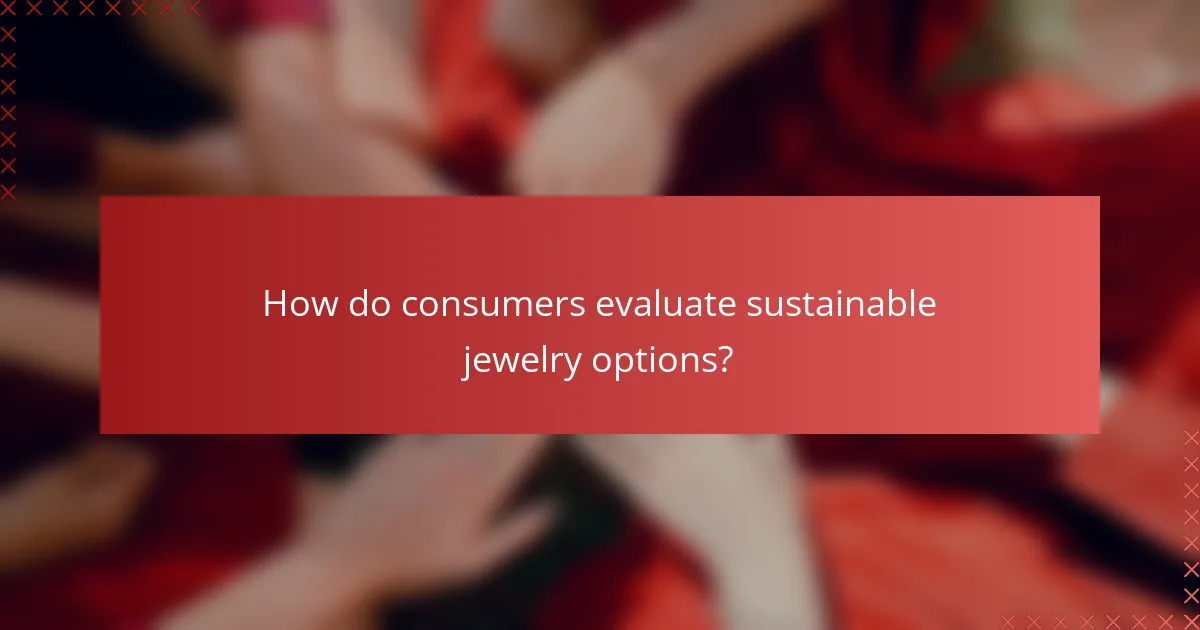
How do consumers evaluate sustainable jewelry options?
Consumers evaluate sustainable jewelry options by considering brand transparency, certifications, customer reviews, and sourcing practices. These factors help determine the environmental and ethical impact of the jewelry they purchase.
Research brand transparency
Brand transparency refers to how openly a jewelry company shares information about its practices and supply chain. Look for brands that provide detailed insights into their sourcing, production processes, and labor practices. A transparent brand is more likely to adhere to sustainable practices.
Check if the brand has a clear mission statement regarding sustainability and whether they publish annual sustainability reports. This can indicate their commitment to ethical practices.
Check for certifications
Certifications can serve as reliable indicators of a brand’s sustainability efforts. Look for recognized certifications such as Fair Trade, Responsible Jewelry Council (RJC), or the Kimberley Process, which ensure ethical sourcing and production standards.
These certifications often require brands to meet specific environmental and social criteria, providing consumers with assurance that their purchases support sustainable practices.
Read customer reviews
Customer reviews can provide valuable insights into the sustainability of jewelry brands. Look for feedback that specifically mentions the brand’s commitment to ethical sourcing, quality, and transparency.
Platforms like social media, review websites, and forums can help gauge consumer sentiment. Pay attention to patterns in reviews, such as repeated mentions of sustainable practices or concerns about the brand’s ethics.
Compare sourcing practices
Understanding a brand’s sourcing practices is crucial for evaluating sustainability. Research where and how the materials are sourced, including the mining or production methods used for metals and gemstones.
Brands that prioritize recycled materials or ethically sourced stones often have a lower environmental impact. Comparing these practices among different brands can help you make informed choices that align with your values.
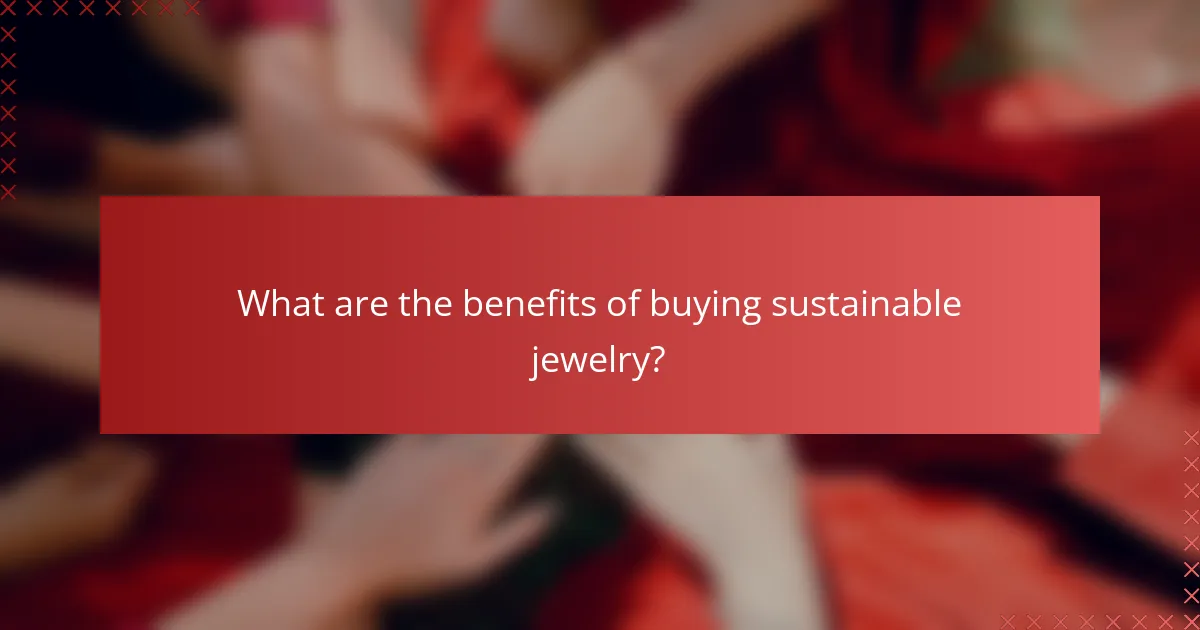
What are the benefits of buying sustainable jewelry?
Buying sustainable jewelry offers numerous advantages, including a reduced environmental footprint and support for ethical labor practices. These benefits contribute to a more responsible and conscious approach to jewelry consumption.
Environmental impact reduction
Sustainable jewelry significantly lowers its environmental impact by utilizing eco-friendly materials and responsible sourcing methods. This includes using recycled metals, ethically mined gemstones, and sustainable packaging, which collectively help to minimize resource depletion and pollution.
For example, brands that focus on recycled gold can reduce the energy and water usage associated with traditional mining. Additionally, many sustainable jewelry companies adhere to strict environmental standards, ensuring that their production processes are as eco-friendly as possible.
Support for ethical labor
Purchasing sustainable jewelry often means supporting brands that prioritize ethical labor practices. This includes fair wages, safe working conditions, and respect for workers’ rights throughout the supply chain. By choosing these brands, consumers can help promote social responsibility in the jewelry industry.
Many sustainable jewelry brands are transparent about their sourcing and labor practices, often providing information on their websites about the artisans and communities involved. This transparency allows consumers to make informed choices and support businesses that align with their values.
